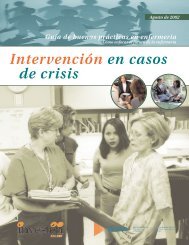Reducing Foot Complications for People with Diabetes - Registered ...
Reducing Foot Complications for People with Diabetes - Registered ...
Reducing Foot Complications for People with Diabetes - Registered ...
You also want an ePaper? Increase the reach of your titles
YUMPU automatically turns print PDFs into web optimized ePapers that Google loves.
<strong>Reducing</strong> <strong>Foot</strong> <strong>Complications</strong> <strong>for</strong> <strong>People</strong> <strong>with</strong> <strong>Diabetes</strong><br />
22<br />
(a 29% decline from 1995 to 1999). However, rates <strong>for</strong> minor amputations were much higher<br />
in the diabetic population compared to the non-diabetic population – in 1999 the odds of<br />
having a minor amputation were 24 times greater in people <strong>with</strong> diabetes. Major amputation<br />
rates (amputation from the ankle to the thigh) remained relatively stable in Ontario over the<br />
same five-year interval; however rates increased <strong>with</strong> age and were significantly higher<br />
in those <strong>with</strong> diabetes. As <strong>with</strong> minor amputation rates, major amputation rates were<br />
significantly higher <strong>for</strong> people <strong>with</strong> diabetes. In 1999, the risk of major amputation was 14 times<br />
higher <strong>for</strong> those <strong>with</strong> diabetes, even after adjusting <strong>for</strong> differences in age and sex.<br />
Abbott et al. (2002) found that the incidence of foot ulcers in people <strong>with</strong> diabetes was 2.2%<br />
annually, and that past history of foot ulcers or history of amputation was strongly related to<br />
future ulcer risk. The sequence of events leading to lower extremity ulceration and amputation<br />
in diabetes is a complex process <strong>with</strong> many factors combining to increase the likelihood that<br />
a foot injury or infection will occur and healing will be delayed. In the presence of reduced<br />
circulation (peripheral vascular disease) and loss of protective sensation (neuropathy), even<br />
minor foot trauma or unusual pressures on the foot may be sufficient to cause ulceration<br />
and eventual amputation. For example, in the insensate foot a callus is an ulcer waiting<br />
to happen. Fully 85% of lower extremity amputations are preceded by non-healing ulceration<br />
(Pecoraro, Reiber & Burgess, 1990).<br />
The prevention of such traumatic “pivotal” events, together <strong>with</strong> the early identification and<br />
prompt treatment of foot problems can reduce the incidence of foot ulceration and amputation.<br />
This can be achieved through a program of risk assessment, self-care education and regular<br />
rein<strong>for</strong>cement of self-care (Mayfield et al., 1998). Valk, Kriegsman and Assendelft (2002) in a<br />
systematic review of the effectiveness of patient education to prevent diabetic foot ulcers,<br />
found that the evidence suggests patient education may have positive short-term effects on<br />
foot care knowledge and behaviour of patients, and may reduce foot ulceration and amputation,<br />
particularly in high-risk patients.<br />
Not only does diabetes seriously affect the lives of individuals and their families, it poses a<br />
significant societal burden as well. The Canadian <strong>Diabetes</strong> Association (2003) indicates that<br />
although economic analyses of the cost of diabetes to the Canadian health care system vary<br />
widely, a recent study calculated that the economic costs of diabetes in Canada in 1998 was<br />
between $4.76 billion and 5.23 billion (US).
















